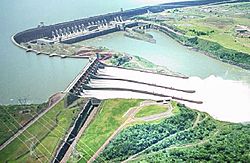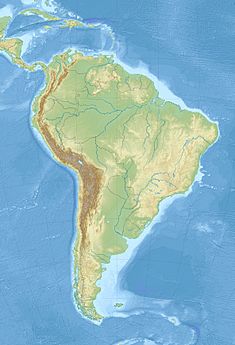Itaipu Dam facts for kids
Quick facts for kids Itaipu DamPresa Itaipu Barragem de Itaipu |
|
|---|---|
 |
|
|
Location of the Dam
|
|
| Official name | Central Hidroeléctrica Itaipú Binacional Usina Hidrelétrica Itaipu Binacional |
| Country | Brazil Paraguay |
| Location | Foz do Iguaçu Hernandarias |
| Coordinates | 25°24′29″S 54°35′20″W / 25.40806°S 54.58889°W |
| Status | Operational |
| Construction began | January 1971 |
| Opening date | 5 May 1984 |
| Construction cost | US$19.6 billion |
| Owner(s) | Itaipu Binational |
| Dam and spillways | |
| Type of dam | Combination gravity, buttress and embankment sections |
| Impounds | Paraná River |
| Height | 196 m (643 ft) |
| Length | 7,919 m (25,981 ft) |
| Dam volume | 12,300,000 m3 (430,000,000 cu ft) |
| Spillway capacity | 62,200 m3/s (2,200,000 cu ft/s) |
| Reservoir | |
| Creates | Itaipu Reservoir |
| Total capacity | 29 km3 (24,000,000 acre⋅ft) |
| Catchment area | 1,350,000 km2 (520,000 sq mi) |
| Surface area | 1,350 km2 (520 sq mi) |
| Maximum length | 170 km (110 mi) |
| Maximum width | 12 km (7.5 mi) |
| Power station | |
| Type | Conventional |
| Hydraulic head | 118 m (387 ft) |
| Turbines | 20 × 700 MW (940,000 hp) Francis-type |
| Installed capacity | 14 GW (19,000,000 hp) |
| Capacity factor | 73% |
| Annual generation | 89.5 TWh (322 PJ) (2015) |
| Website www.itaipu.gov.br www.itaipu.gov.py |
|
The Itaipu Dam is a huge hydroelectric dam built on the Paraná River. It sits right on the border between two countries: Brazil and Paraguay. This amazing dam helps create electricity using the power of water.
The name "Itaipu" comes from an island that used to be near where the dam was built. In 2016, the Itaipu Dam's power plant made more energy than any other in the world. It set a new record of over 103 million megawatt hours (MWh). The dam was finished in 1984. It is a joint project, meaning both Brazil and Paraguay work together to run it.
Contents
Building the Itaipu Dam
How the Dam Was Planned and Started
People started studying how to design the dam in February 1971. On April 26, 1973, Brazil and Paraguay signed an agreement called the Itaipu Treaty. This treaty made it legal for them to use the Paraná River to make electricity.
On October 14, 1978, the path of the Paraná River was changed. This allowed a part of the riverbed to dry out. Workers could then build the dam in that dry area.
Filling the Reservoir
The huge lake behind the dam, called the reservoir, started to form on October 13, 1982. This happened when the dam was finished and its side gates were closed. There was a lot of rain and flooding during this time. This made the reservoir fill up very quickly. The water rose 100 meters (328 feet) and reached the spillway gates by October 27.
On May 5, 1984, the very first power unit at Itaipu started working. The first 18 power units were put in place over several years. The last two of these units began running in 1991.
Amazing Facts About Construction
- The path of the world's seventh-largest river was changed. Workers also moved 50 million tons of earth and rock.
- Enough concrete was used to build the Itaipu Power Plant to make 210 football stadiums. Each stadium would be as big as the famous Estádio do Maracanã.
- The amount of iron and steel used could build 380 Eiffel Towers.
- The amount of earth and rock dug out for Itaipu was 8.5 times more than for the Channel Tunnel. The amount of concrete was 15 times more.
- About 40,000 people worked on building the dam.
- Itaipu is one of the most expensive things ever built in the world.
The Dam and Power Plant
Size and Structure of the Dam
The total length of the Itaipu Dam is 7,235 meters (about 4.5 miles). The top of the dam is 225 meters (738 feet) above sea level. Itaipu is actually made of four different dams joined together. These include an earth-fill dam, a rock-fill dam, a concrete buttress main dam, and a concrete wing dam.
The dam is 196 meters (643 feet) high. This is as tall as a 65-story building!
How the Spillway Works
The spillway is a part of the dam that lets extra water flow out. It is 483 meters (1,585 feet) long. The spillway has 14 sections and can release a huge amount of water. Its maximum flow is 62,200 cubic meters per second. This is like 40 times the average flow of the nearby natural Iguaçu Falls.
Even the flow of just two generators (700 cubic meters per second each) is almost equal to the average flow of the Iguaçu Falls (1,500 cubic meters per second).
The Reservoir and Energy Production
The Itaipu reservoir is the seventh largest in Brazil. However, it is very good at producing electricity for the amount of land it covers. For every 14,000 megawatts (MW) of power it can make, it only flooded 1,350 square kilometers (521 square miles) of land.
Other dams in Brazil have larger reservoirs but make less electricity. For example, the Tucuruí Dam has a capacity of 8,000 MW. But it flooded 2,430 square kilometers (938 square miles) of land. Electricity made by the Itaipu Dam is also about 55% cheaper than from other power plants in the area.
A Modern Wonder
In 1994, the American Society of Civil Engineers chose the Itaipu Dam. They named it one of the seven modern Wonders of the World. The American magazine Popular Mechanics published these results in 1995.
Images for kids
See also
 In Spanish: Represa de Itaipú para niños
In Spanish: Represa de Itaipú para niños






